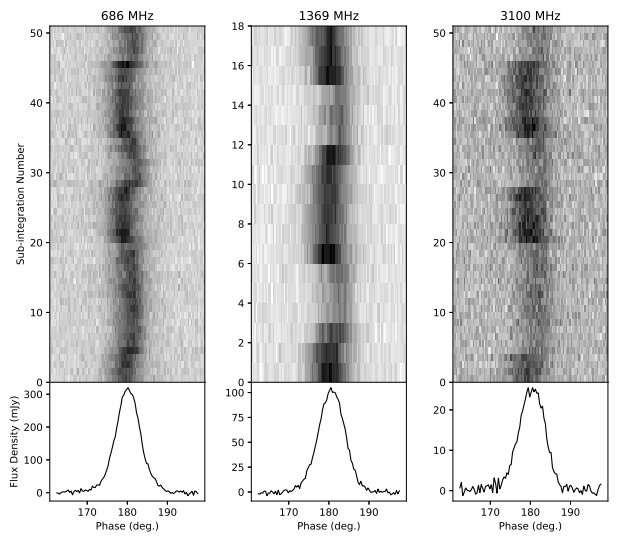December 18, 2019 report
Parkes radio telescope observations shed more light on the mode switching phenomenon in PSR J0614+2229

Using Parkes radio telescope in Australia, Chinese astronomers have conducted a multifrequency study of the pulsar PSR J0614+2229 (also known as B0611+22). The new research, presented in a paper published December 9 on arXiv.org, provides insight into the mode switching phenomenon occurring in this pulsar.
Pulsars are highly magnetized, rotating neutron stars emitting a beam of electromagnetic radiation. Some of them showcase variability in emission ranging from extremely short bursts like giant pulses to long-term changes in their emission profiles. In some cases, mode changing has been observed in which the emission profile switches between two or more quasi-stable modes of emission.
Discovered in 1972, PSR J0614+2229 is a young (about 90,000 years old) pulsar with a period of approximately 0.33 seconds. Observations of this pulsar have revealed that it exhibits emission profile variability caused by mode switching. In particular, it was found that the pulsar switches between two emission modes: one mode occurring earlier in pulse phase (mode A) and the other mode appearing later in phase (mode B), with a generally stable phase offset between their profile peaks.
A team of astronomers led by Yanrong Zhang of Guangzhou University, China, studied the emission modes of PSR J0614+2229 and the switching between them. For this purpose, they analyzed archival observations of this pulsar with the Parkes telescope at 686 MHz, 1,369 MHz and 3,100 MHz. The study was complemented by data from other ground-based observatories like the Low-Frequency Array (LOFAR), Arecibo Observatory and the Green Bank Telescope (GBT).
"In this paper, the frequency dependence of emission properties, i.e., the intensity, pulse width and phase offset, are studied in detail for the two modes by using multifrequency data that are both observed with the Parkes radio telescope and collected from literature," the astronomers wrote in the paper.
The research revealed that mode A has a flatter spectrum than mode B, with a difference in the spectral indices of about 0.5. Mode A was found to be weaker than mode B at low frequencies, but due to the spectral difference, it turned out that it surpasses mode B at the frequency of approximately 500 MHz.
According to the study, the full width of half maximum (FWHM) of mode A increases with frequency, while that of mode B decreases with frequency. Therefore, the frequency dependence of FWHM of the two modes are opposite to each other. The astronomers offered an explanation of this behavior. "Our simulation suggests that two opposite types of spectral variation across the beam along the line of sight can account for the difference in the frequency dependence of pulse width, namely, the spectrum becomes steeper from the edge to the center for mode A, while it is the opposite to mode B," the researchers noted.
Moreover, the study found that when it comes to mode B, the peak amplitude and the flux density of sub-integrated profile are anticorrelated with the phase of the pulse peak. This suggests that the emission at earlier phases is relatively stronger. However, such anti-correlation was not observed in mode A.
The astronomers added that simultaneous observations of PSR J0614+2229 at broad radio bands are needed to get more insights into the mode switching phenomenon of this pulsar.
More information: Multifrequency Study on The Mode Switching of PSR J0614+2229, arXiv:1912.04156 [astro-ph.HE] arxiv.org/abs/1912.04156
© 2019 Science X Network




















